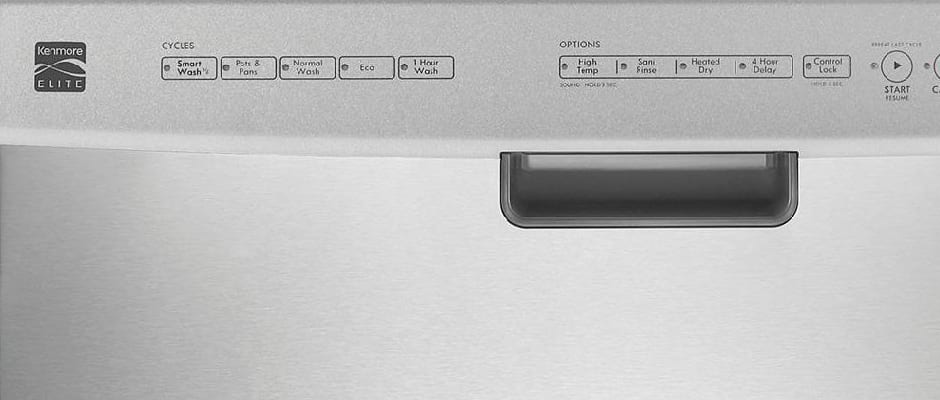Pros
Cons
Introduction
We usually have nothing against the humdrum, but in this case, maybe you should live a little. If performance is as unexciting as the edifice, you'll want to keep on shopping.
Design & Usability
{{section_header}}{{section.name}}{{/section_header}}
At least it has stainless and a fancy spray arm setup.
Some dishwashers put their controls on the front without ruining the appliance's overall aesthetic. See the Red Dot Design Award-winning Asko D5434XXLS as a perfect example. By comparison, this Kenmore's front controls just look cheap. A matchy-matchy silver plastic console isn't fooling anyone, and it seriously disrupts the stainless exterior.
Inside, there's room for only nine place settings, which is just a little more cramped than other machines we've tested. A stainless interior speeds drying and makes for a quieter wash, while a unique spray system called TurboZone fires water from the back of the washer to try and do a more effective cleaning job on heavily soiled dishes and pans. The upper arm fires water up into the cups, glasses and dishes on the top rack. Both the top and bottom arms are curved, which allows more water jets to fit into the width of each one.
{{photo_gallery "Front Closed Photo", "Fingerprints Photo", "Controls 1 Photo", "Controls 2 Photo", "Front Open Photo", "Interior Detail Photo", "Top Rack Photo", "Top Rack Detail Photo 1", "Top Rack Detail Photo 2", "Top Rack Detail Photo 3", "Bottom Rack Photo", "Bottom Rack Detail Photo 2", "Bottom Rack Detail Photo 3", "Cutlery Basket Photo", "Cutlery Basket Detail Photo 1", "Cutlery Basket Detail Photo 2", "Cutlery Basket Detail Photo 3"}}
Features
{{section_header}}{{section.name}}{{/section_header}}
This appliance offers a limited selection of cycles, with no china or glassware modes.
The Kenmore Elite 13923 offers a rather limited selection of cycles, with no delicate wash or glassware cycles. This seems like an odd omission, but there are enough cycles for most users.
There are no options for customizing the cycles: you cannot change the wash level or heating levels. In fact, the only additional wash option on offer is a four hour delay. You can’t change the length of this delay, nor can you add extra rinses, sanitize, or any of the other options that some washers offer.
Performance
{{section_header}}{{section.name}}{{/section_header}}
There's a direct correlation between cycle length and cycle performance.
The Kenmore Elite 13923 favors performance over speed, so the cycles are generally on the long side. The exception to this is the 1-Hour Wash, but that had rather poor performance. The Normal cycle did a pretty adequate job, although a third of our test load still wasn't clean enough for reuse. A three and a quarter hour Pots & Pans cycle may have taken its time, but it did a decent job getting tough stains off our test load.
When it comes to efficiency, we calculated that this washer would cost about $36.29 a year to run, which is pretty average for washers of this size and type.
Conclusion
{{section_header}}{{section.name}}{{/section_header}}
There's absolutely nothing outstanding about this dishwasher.
The Kenmore Elite 13923 fits into a very competitive price range, that sweet spot between $600 and $800 where dishwashers start to show off high-end features. It’s noticeable, then, that the Kenmore doesn’t have a hidden control panel, customizable wash cycles, a delicate/glassware cycle, or even enough room for 10 place settings. It’s even more noticeable that it doesn’t do as good a job cleaning as some of its closely-priced competitors.
For the same price, you could get a dishwasher that's better looking, more efficient, and more effective. Another reason to hold back on this dishwasher: Kenmore appliances are only sold at Sears, so it's $999 MSRP is pretty much etched in stone unless Sears has a sale. If they do, the price usually gets knocked down to about $799, and even that's not very inspiring.
Science Introduction
{{section_header}}{{section.name}}{{/section_header}}
We give every dishwasher we test the same load of standard plates with standardized, baked-on stains. It's a lot messier than the remnants of most dinner parties, but it helps us see where a dishwasher struggles and where it shines. In the case of this Kenmore, we weren't tremendously impressed.
Cleaning Performance
{{section_header}}{{section.name}}{{/section_header}}
The longer it takes, the better it cleans.
The Quick cycle had some problems with the heavily stained dishes we use in our testing, failing to shift some of the milk, tea, meat, egg and spinach stains. For all of these, at least one of our test dishes remained unclean, with over half of our dishes still sporting enough visible traces of refuse that rewashing was in order. We would not recommend this cycle unless it's for only very lightly stained dishes: anything heavier than a splash or two may not get clean.
The Normal cycle is the one for everyday mixed loads, and this showed better performance, with much more of our test stains coming off. Here, we found that out meat stains were completely removed specifically from plates, with only a few small stains remaining on many of our other dishes. There were still a marked number of dishes that would require rewashing, though: just under a third of the test load.
The Heavy cycle is where we really let the washer go: here, we use the cycle designed for cleaning pots and pans, and add a number of cooking dishes to our load with baked-on stains such as cheese and sugar. For the Kenmore Elite 13923, we used the Pots & Pans cycle, and found it did reasonably well, shifting the stains from most of our dishes. Some did remain, though: we found that there were still a couple of spots of baked-on sauce on our lasagna dish, and a few remaining traces of egg on our cutlery. It also failed to shift much of the lipstick that we put on the rim of our test cups.
{{photo_gallery "Science Section 1 Images"}}
Efficiency
{{section_header}}{{section.name}}{{/section_header}}
Not an energy hog, but not a miser either
We found that this washer used quite a bit of electricity during use, ranging from 0.32 kWh for the Quick wash up to over 2 kWh for the Pots & Pans cycle.
The water use of this washer also varied a great deal, from the 4.14 gallons of the Normal cycle to the 7.34 gallons used in the 1-Hour Wash.
{{photo_gallery "Science Section 2 Images"}}
Capacity
{{section_header}}{{section.name}}{{/section_header}}
{{photo_gallery "Other Tests Images"}}
Meet the tester
Keith was the Editor in Chief of Reviewed's appliance and automotive sites. His work has appeared in publications such as Wired, Car & Driver, and CityLab.
Checking our work.
Our team is here to help you buy the best stuff and love what you own. Our writers, editors, and experts obsess over the products we cover to make sure you're confident and satisfied. Have a different opinion about something we recommend? Email us and we'll compare notes.
Shoot us an email

